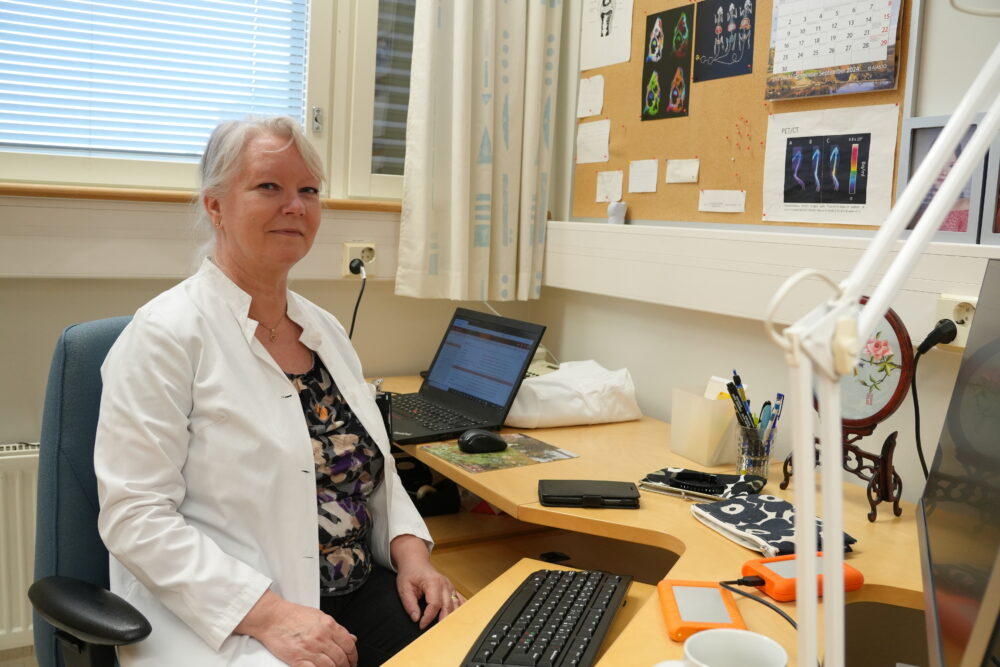Anne Roivainen: The Best Thing Is To Go Where No Researcher Has Gone Before
“We now have a brand-new tool and we even have developed it ourselves. It is great to get the chance to conduct research on something that no one else has studied before,” says Professor Anne Roivainen, InFLAMES group leader.

With the new tool, Roivainen refers to the 68Ga-DOTA-Siglec-9 radiopharmaceutical used in positron emission tomography (PET) imaging. The Siglec-9 molecule appears on the surface of leukocytes and is bound, like a key to a lock, to the VAP-1 molecule, which controls leukocyte infiltration into tissues. The radiopharmaceutical was developed under the leadership of Anne Roivainen at Turku PET Centre.
“This took ten years and research had to meet all the criteria and requirements set for any pharmaceutical development project,” says Roivainen.
68Ga-DOTA-Siglec-9 has also been used as a tool now that Anne Roivainen and her team are conducting research on how chemotherapy and immunotherapy used in cancer treatment affect the bone marrow.
“Sirpa Jalkanen’s group discovered already earlier that during treatment, something happens to the VAP-1 molecule in the bone marrow. We have now scanned four melanoma patients with a PET scanner and it truly seems that the VAP-1 level in the bone marrow is increasing as a result of immunotherapy. This means that there is an inflammatory reaction in the bone marrow and the immune system[RA1] is working.”
The fact that the immune system is working is usually good, but sometimes it would be beneficial to be able to inhibit leukocyte activity.
“Patients with acute myeloid leukaemia are treated with stem cell transplants and the inflammatory reaction may be harmful to them. We are interested in whether treatment results could be improved by using VAP-1 inhibitors, i.e. preparations that suppress VAP-1 activity. They are already in clinical use,” says Anne Roivainen.
Looking into something completely new, the significance of the results still open
Four patients are just the beginning for research, in which a total of thirty patients are to be included. In addition to those receiving treatment for melanoma, the research target group includes lung cancer and leukaemia patients. Anne Roivainen says that their research is looking into something completely new and that no one can yet be sure where the results will lead to. Still, she does not consider her research to be basic research but closer to translational research. One thing is certain: no one else has researched this!
Anne Roivainen’s and Antti Saraste’s joint research group at Turku PET Centre consists of fourteen researchers. The group’s areas of interest include myocarditis, inflammations of the gastrointestinal tract, and the efficacy of pharmacotherapy. For Anne Roivainen, this diverse range of topics is perfect.
“I’m inspired by many kinds of things and I always want to learn something new,” she says.
Anne wrote her thesis in Kuopio, in the Faculty of Natural & Health Sciences, and her doctoral dissertation in Turku, in the Department of Medical Microbiology and Immunology. The topic of her doctoral dissertation was rheumatoid arthritis. After that, the young researcher wanted to do something completely different, which meant transferring to Turku PET Centre and establishing her own research group. She also made a detour to Uppsala, where she studied 68-gallium chemistry, after which she continued her work in Finland with a grant from the Finnish Cancer Institute and then as Research Council of Finland Postdoctoral Researcher and Academy Research Fellow.
“Cancer and rheumatoid arthritis have always played a role in my career, but in general, one could say that I have always conducted research related to human diseases and biology.”
And what are the next challenges?
“We are developing a new PET radiopharmaceutical, which seems so good that progress should definitely be made in that field. However, it would require a considerable amount of money, even more, which was required by the development of 68Ga-DOTA-Siglec-9, partly because the regulatory requirements have further tightened. With Antti Saraste, we are interested in myocarditis, a serious heart disease that affects especially young people. It is very difficult to verify it, in other words, a marker that indicates the disease should be found.”
Liisa Koivula
